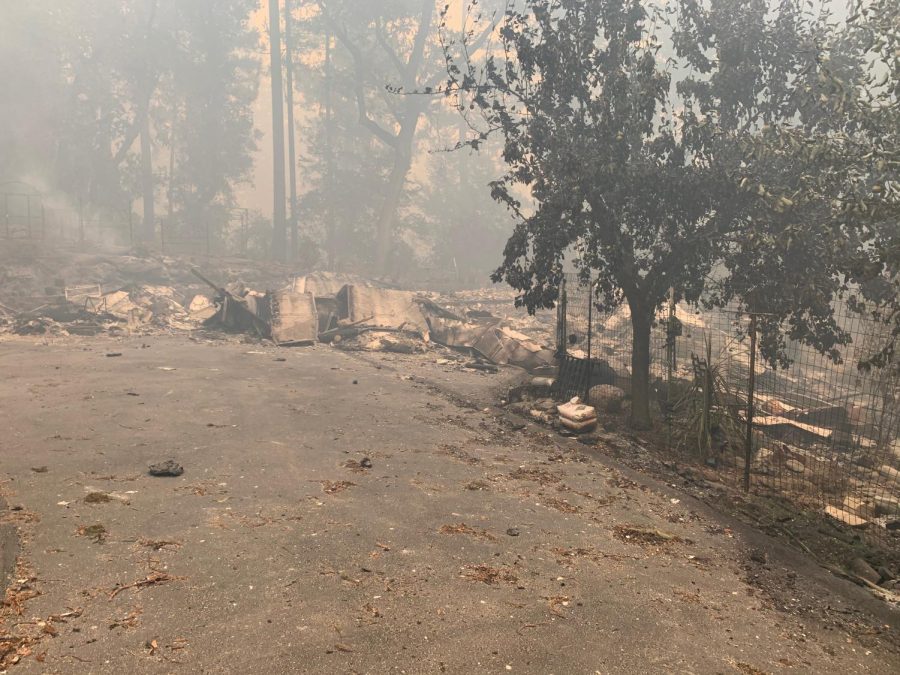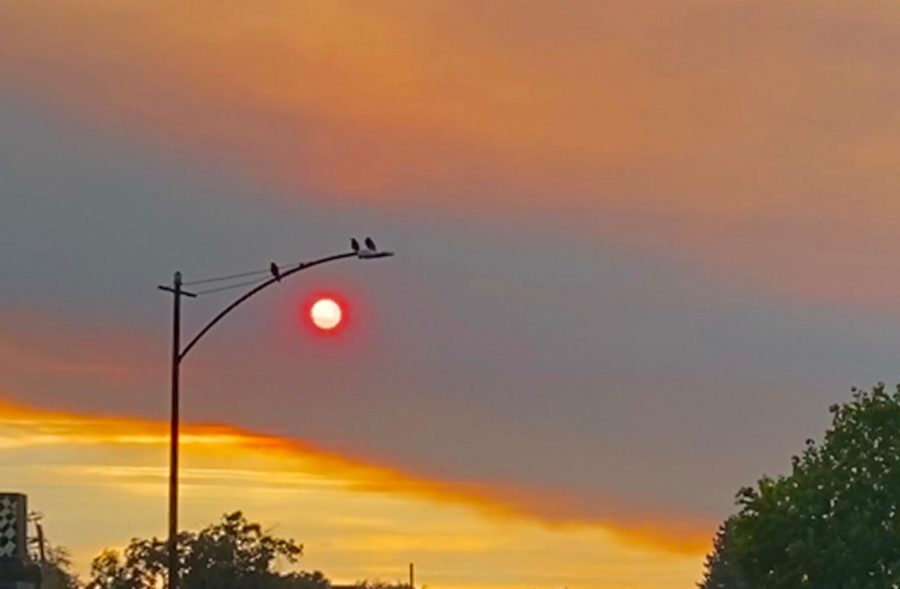Fleeing fires: Evacuated community members face challenges with new reality
Provided by Kerry Enzensperger
Upper school English teacher Beverley Manning’s house was burned to the ground by the CZU Lightning Complex Fire, which has now burned over 86,000 acres. Manning evacuated from the wildfire with her rescued animals.
September 8, 2020
Since a heat wave struck California on Aug. 14, over 900 fires have rolled through 1.8 million acres, destroying at least 3,400 structures, according to Gov. Gavin Newsom during a press conference today.
Californians experienced extreme heat over Labor Day weekend, with Newsom declaring a state of emergency in the counties of Fresno, Madera, Mariposa, San Bernardino and San Diego on Sunday in response to the recently-started Creek Fire, El Dorado Fire and Valley Fire.
The SCU Lightning Complex, east of San Jose, is now 94% contained, and the CZU Lightning Complex in the Santa Cruz Mountains is 81% contained. Meanwhile, the August Complex Fire, which started in the Mendocino National Forest, is 24% contained and the Creek Fire in Fresno and Madera County is 0% contained. Even with high containment numbers for some fire clusters, Newsom encouraged residents to remain “mindful” of the wildfires.
Upper school computer science department chair and physics teacher Dr. Eric Nelson, whose house is in Boulder Creek, evacuated at 11:30 p.m. on Aug. 18. He is currently staying with family members in San Jose and teaching classes from his classroom at the upper school.
“The anxiety and the uncertainty is probably the hardest part,” he said. “If I knew my house had burned down, then I would contact my insurance company, and I would contact my tax guy, and I would contact my daughter to get the caravan down here, and start doing all that coordination because life has to continue. On the other hand, I don’t need any of that if my house is still in one piece.”
After evacuating, Dr. Nelson has monitored the progress of the fires near his house through satellite. While he is still an evacuee, his house remains intact.
“I’ve been watching the fire lines via satellite, and all it is is red, orange, and yellow dots, that’s all I see,” he said on Aug. 25. “But I can interpret the motion of those dots and watch over 3-hour increments as the fire moves through the mountains and through my neighborhood. And as I watched that over the last week, it’s like watching a tree fall on a child in slow motion. It’s really miserable, because you can’t do anything about it.”
Upper school biology teacher Dr. Thomas Artiss, whose house is in the Bonny Doon area of the Santa Cruz Mountains, evacuated on Aug. 19 after receiving an alert at 1 a.m. His wife had left to drive to Virginia on the same day, so he evacuated with his pets.
“My wife and I had already discussed what to bring in case this happened, so I was pretty efficient in grabbing important documents, photos and a few keepsakes and getting the stuff loaded in the car,” he said in an email interview with Harker Aquila. “We have 4 dogs and a cat, so I had to round up all the animals – and I managed to get off the mountain fairly quickly.”
After initially staying with friends in Scotts Valley, Dr. Artiss relocated to Santa Barbara, where he is now staying with his wife in a family member’s condo, four hours away from his house in the Santa Cruz Mountains. His new living situation has posed challenges. He and his wife walk the dogs more often to keep them from barking in a smaller living situation, and the noisy neighborhood and airport near the condo make Zoom calls more difficult.
“The only thing I ask of the students I teach is to understand that this is not normal for me, and that it’s not the way I usually present myself,” he said. “I am less prepared than normal, I only have 3 or 4 t-shirts I managed to grab so I look less professional on Zoom, I am more distracted than usual.”
As far as he is aware, his house is still standing, although he is expecting significant smoke damage.
Senior Sophia Gottfried evacuated from her house, which is still standing, in the Sky Londa area of San Mateo County at midnight on Aug. 20. After staying in a hotel for a day and a half, she flew to a family-rented house in Florida and has been attending Zoom classes despite a difference in time zones. She and her family are closely monitoring the air quality levels in the Sky Londa region and have booked tickets for a flight back to California on Saturday.
“The first few days [of evacuating], everyone [in my family] was extremely stressed,” she said. “I was having stress dreams about getting burned alive, my sister was all panicky about her ping pong table. It was just that atmosphere of panic. We were so relieved when our front got contained fairly quickly.”
Upper school English teacher Beverley Manning’s house was burned down by the CZU Lightning Complex. Click here to donate to a fundraiser organized on her behalf by upper school director of community service Kerry Enzensperger, director of alumni relations Kristina Alaniz and head athletic trainer Jaron Olson. Proceeds will be going to support Manning in buying a recreational vehicle (RV) to live in until her home can be rebuilt.
Upper school math teacher Dana Lieberman, who lives in the Santa Cruz Mountains, was on high alert as the CZU Lightning Complex burned through parts of the mountains, and she had packed her car in case of evacuation. She is currently still safe and in her home, although the stress accompanying the fires did take a toll and cause feelings of survivor’s guilt.
“With regard to my home, the metaphor ‘we’re almost out of the woods’ comes to mind, but the reality is we will never be out of the woods,” she said in an email interview with Harker Aquila. “27 years ago I chose to live in a forest, and global warming has radically changed what that means.”
Additional reporting by Aditya Singhvi.


















![“[Building nerf blasters] became this outlet of creativity for me that hasn't been matched by anything else. The process [of] making a build complete to your desire is such a painstakingly difficult process, but I've had to learn from [the skills needed from] soldering to proper painting. There's so many different options for everything, if you think about it, it exists. The best part is [that] if it doesn't exist, you can build it yourself," Ishaan Parate said.](https://harkeraquila.com/wp-content/uploads/2022/08/DSC_8149-900x604.jpg)




![“When I came into high school, I was ready to be a follower. But DECA was a game changer for me. It helped me overcome my fear of public speaking, and it's played such a major role in who I've become today. To be able to successfully lead a chapter of 150 students, an officer team and be one of the upperclassmen I once really admired is something I'm [really] proud of,” Anvitha Tummala ('21) said.](https://harkeraquila.com/wp-content/uploads/2021/07/Screen-Shot-2021-07-25-at-9.50.05-AM-900x594.png)







![“I think getting up in the morning and having a sense of purpose [is exciting]. I think without a certain amount of drive, life is kind of obsolete and mundane, and I think having that every single day is what makes each day unique and kind of makes life exciting,” Neymika Jain (12) said.](https://harkeraquila.com/wp-content/uploads/2017/06/Screen-Shot-2017-06-03-at-4.54.16-PM.png)








![“My slogan is ‘slow feet, don’t eat, and I’m hungry.’ You need to run fast to get where you are–you aren't going to get those championships if you aren't fast,” Angel Cervantes (12) said. “I want to do well in school on my tests and in track and win championships for my team. I live by that, [and] I can do that anywhere: in the classroom or on the field.”](https://harkeraquila.com/wp-content/uploads/2018/06/DSC5146-900x601.jpg)
![“[Volleyball has] taught me how to fall correctly, and another thing it taught is that you don’t have to be the best at something to be good at it. If you just hit the ball in a smart way, then it still scores points and you’re good at it. You could be a background player and still make a much bigger impact on the team than you would think,” Anya Gert (’20) said.](https://harkeraquila.com/wp-content/uploads/2020/06/AnnaGert_JinTuan_HoHPhotoEdited-600x900.jpeg)

![“I'm not nearly there yet, but [my confidence has] definitely been getting better since I was pretty shy and timid coming into Harker my freshman year. I know that there's a lot of people that are really confident in what they do, and I really admire them. Everyone's so driven and that has really pushed me to kind of try to find my own place in high school and be more confident,” Alyssa Huang (’20) said.](https://harkeraquila.com/wp-content/uploads/2020/06/AlyssaHuang_EmilyChen_HoHPhoto-900x749.jpeg)














